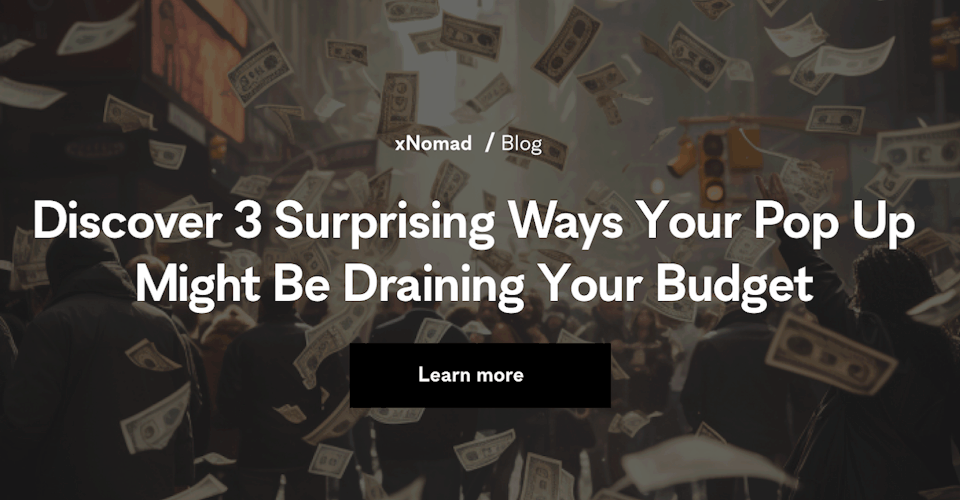Discover 3 Surprising Ways Your Pop Up Might Be Draining Your Budget
In order to offer a distinctive and interesting shopping experience, pop-up stores have grown to be a popular alternative among entrepreneurs and digitally native enterprises. However, without proper management and planning, your pop-up shop may be unexpectedly draining your finances. We'll look at three unexpected ways that your pop-up ad can be influencing your finances in this post and offer strategies to help you recover control.

Share
Pop-up shops are temporary shops that enable companies to present their goods, build brand recognition, and interact with customers in novel ways. They can, however, incur unnecessary costs and have a detrimental financial impact if they are not managed well.
Way 1: Inefficient Space Utilization
One way your pop up might be draining your budget is through inefficient space utilization. Oversized display areas and excessive storage space can lead to wasted resources and increased costs.
For example, renting a larger space than necessary can result in higher rental fees and increased utility costs. Consider carefully assessing your display and storage needs to optimize your space utilization. Don’t forget to check on the space before renting in order to check the balance between retail space and storage space to see if it matches your needs. If you are unsure about the right size for your pop up, check out our article on pop up size to learn about factors to consider when determining the size of your pop up store.
Way 2: Costly Marketing Strategies
Another way your pop up store may be breaking the bank is through costly marketing strategies. High advertising expenses and ineffective promotional tactics can eat away at your finances without yielding the desired results.
For instance, investing in expensive print ads or digital campaigns without a targeted approach may not generate the desired foot traffic or sales. It's important to evaluate marketing plans and concentrate on cost-effective solutions that successfully engage your target market.
Way 3: Poor Inventory Management
Poor inventory management is a hidden culprit that can drain your pop up store budget. Overstocking inventory or lacking proper inventory tracking systems can lead to unnecessary costs and lost revenue opportunities.
For instance, overstocking inventory ties up your capital and may result in unsold products that need to be discounted or discarded. For a pop up, make sure that you offer a way for customers to order from your online store as well. That way, if you run out, your customers can still purchase from you when in the store. Invest in rapid delivery, as no one is willing to wait 2 weeks for something they expected to buy when walking into a store.
Take Control of Your Pop Up Budget
It's critical to put good cost management measures into place if you want to reclaim control of your pop-up store budget. The following are some concrete steps you can take:
Conduct a Cost Analysis: Evaluate all your expenses, including rent, utilities, marketing, staffing, and inventory. Identify areas where you can cut costs or make adjustments.
Optimize Space and Resources: Maximize your space utilization by carefully planning your display areas and storage. Consider sharing space with complementary brands or exploring alternative, cost-effective locations.
Implement Effective Marketing Strategies: Focus on targeted marketing campaigns, leveraging social media, email marketing, and collaborations. Track your marketing efforts' ROI to ensure you are allocating your resources effectively. Check out our LinkedIn post to get some inspiration to improve your store ROI.
Streamline Inventory Management: Invest in inventory management systems that allow for accurate tracking, forecasting, and replenishment. Find a space that ensures your perfect balance between storage space and retail space to minimize waste and improve cash flow.
By taking these steps, you can ensure that your pop up store operates within your budget while still providing an exceptional customer experience.
xNomad is with you every step of the way
While pop up stores offer exciting opportunities, they can also have unforeseen financial affects. You can keep your pop-up store from blowing your budget by being careful with how much space you use, how much you spend on promotion, and how you handle your inventory. Take charge of your finances by putting cost-cutting strategies into place and making the most of your available resources to build a profitable pop-up shop that offers both priceless experiences and monetary security.
xNomad is with you on the way, from finding your perfect space to finally opening your pop up store.
FAQs
Q: How can I determine the ideal size for my pop up store?
A: Assess your product range, display needs, and customer flow to determine the optimal size for your pop up store. As a starting point, consult the xNomad guide on pop up store sizes to get an idea of your brands needs.
Q: What are some cost-effective marketing strategies for a pop up store?
A: Utilize social media platforms, email marketing, influencer collaborations, and local partnerships to promote your pop up store without incurring excessive expenses.
Q: How often should I track and update my pop up store's inventory?
A: Regularly track and update your inventory to ensure accurate stock levels. The frequency may vary depending on the nature of your business, but it's advisable to conduct weekly or bi-weekly audits.
Q: Should I prioritize foot traffic or targeted marketing for my pop up store?
A: It's crucial to strike a balance between foot traffic and targeted marketing. While foot traffic can increase exposure, targeted marketing helps attract the right audience and maximize conversions.
Q: Can outsourcing certain tasks help reduce costs for my pop up store?
A: Yes, outsourcing tasks such as visual merchandising, cleaning, or inventory management can help reduce costs and allow you to focus on core aspects of your pop up store's operations.